Freshly Printed - allow 8 days lead
Couldn't load pickup availability
Fast Analytical Techniques for Electrical and Electronic Circuits
This unusual 2002 describes a remarkable technique to solve complicated linear circuits in symbolic form.
Vatché Vorpérian (Author)
9780521624718, Cambridge University Press
Paperback, published 3 March 2011
492 pages
24.4 x 17 x 2.5 cm, 0.78 kg
"...the extended and new techniques described in this book are an indispensable set of tools for linear electronic circuit analysis and design...The book is a very timely and welcome one and deserves to be widely used. The numerous problems and worked examples in this book make it an ideal textbook for senior/graduate courses or a reference book that will play a significant role in enhancing students' understanding of circuit operation." Current Engineering Practice
The only method of circuit analysis known to most engineers and students is nodal or loop analysis. Although this works well for obtaining numerical solutions, it is almost useless for obtaining analytical solutions in all but the simplest cases. In this unusual 2002 book, Vorpérian describes remarkable alternative techniques to solve, almost by inspection, complicated linear circuits in symbolic form and obtain meaningful analytical answers for any transfer function or impedance. Although not intended to replace traditional computer-based methods, these techniques provide engineers with a powerful set of tools for tackling circuit design problems. They also have great value in enhancing students' understanding of circuit operation, making this an ideal course book, and numerous problems and worked examples are included. Originally developed by Professor David Middlebrook and others at Caltech (California Institute of Technology), the techniques described here are now widely taught at institutions and companies around the world.
Preface
1. Introduction
2. Transfer functions
3. The extra element theorem
4. The N extra element theorem
5. Electronic negative feedback
6. High-frequency and microwave circuits
7. Passive filters
8. PWM switching DC-to-DC converters.
Subject Areas: Electronics engineering [TJF], Electronics & communications engineering [TJ], Electrical engineering [THR]


